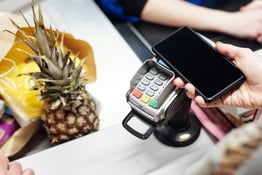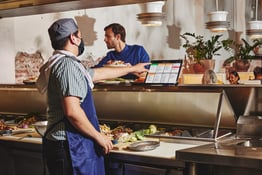When Dallas operator Michelle Carpenter opened her newest restaurant, Restaurant Beatrice, her goals went far beyond producing flavorful food inspired by her mammaw’s Louisiana cooking. Carpenter was on a mission to make a meaningful impact to her community while minimizing the restaurant’s overall effect on the environment.
Now, six months in, Restaurant Beatrice is already forging strong ties with the surrounding Oak Cliff neighborhood, drawing its entire management team from the area. Sustainability focused goals drive the menu, with roughly 30% of the produce sourced from the neighborhood's Restorative Farms. The kitchen practices nose-to-tail cooking and incorporates produce scraps whenever possible, turning citrus peels into cocktail ingredients and many others into stock flavorings. All takeout containers are compostable, and even the menus are repurposed, eventually becoming liners to be placed beneath soup bowls.
“It’s a resetting and recalibration of what we could value. As the culinary world has become more mainstream, we’ve also become more and more removed from our food systems,” says Carpenter. “As a culture, we don’t stop to think about the financial costs, resources, and human labor that it takes to grow a single tomato or the vetting and feed that it takes to raise a single pig – historically, that is someone else’s problem or another generation’s problem.”
As part of her commitment to social responsibility, Carpenter has also applied for a B Corp Certification, given to companies that follow high standards of social and environmental performance, accountability, and transparency. Going for a B Corp Certification is no small undertaking and involves a rigorous assessment process. To date, little more than 6,000 companies worldwide hold a certification, and a mere 37 of those are in the “restaurant and food service” category.
“Certification brings credibility to the changes we are making,” says Carpenter of her decision to apply. “We would make these changes anyway, but certification also helped us audit our operations more comprehensively.”
We sat down with Carpenter to learn more about her goals for Restaurant Beatrice and how she’s breaking industry norms to make her restaurant more sustainable in all directions.
You credit your Mammaw as being a driving influence behind Restaurant Beatrice. Can you tell us a little about your memories of your Mammaw growing up and how that’s helped shape your restaurant today?
It’s not just my Mammaw. It’s each chef who had the great fortune to have a grandmother live long enough to engage them in a kitchen. Many chefs refer to their grandmothers as being integral to their profession. Grandmothers all over the world are under-recognized for their contributions to the culinary arts. Grandmothers create spaces filled with loving, safe, nurturing energy, that involve experiential learning and the joy of creation that results in delicious meals. It’s not flavorful foods that drive people to become chefs. I believe it’s powerful, consistent encounters like mine that include love, intention, memory-making, and skill-building that drive chefs to enter this industry.
I am a half-Japanese, half-Cajun sushi chef who was born in Tokyo but raised in Louisiana and San Antonio. My Mammaw, Beatrice Carpenter, had a garden, smokehouse, and worm farm for fishing. The memories of my Mammaw include picking vegetables, the smell of gumbo on the stove, and crawfish boils on the patio. My co-executive chef is Terance Jenkins, a black man who was born and raised in New Orleans, who moved to Texas after Katrina. Terance [also] has memories with his grandmother, Carabelle, who passed down generational recipes of how to make his ancestors’ food.
You've set out to run a restaurant designed around sustainable food practices. And as part of that, you're getting ingredients directly from your restaurant's own neighborhood. Can you describe your approach to sustainability at Restaurant Beatrice and what you hope to achieve?
The more we do this – operating sustainably, making decisions that respect the environment, refocusing our energy towards our staff’s emotional well-being while maintaining the guest experience, brainstorming ways to reduce waste and costs – the more it becomes like a muscle-memory.
Staff, including myself, have to unlearn the training previous jobs taught them. Staff have to feel comfortable to sometimes say “no” because we can’t accommodate every request. It takes time for new training to coalesce, but our hopes are that this kind of training will not just be an unlearning for staff, but perhaps evolve into an unlearning for our guests to remember that quality doesn’t have to be wasteful.
Can you share a few ways that working with Restorative Farms, and also your sustainability goals, impacts your menu?
Our chefs do all the ordering and shopping for what they want to prepare. If RF has an abundance of berries, we are jamming and canning what we cannot immediately use, and our pastry chef is making a strawberry doberge cake.
A lot of my team didn’t grow up with money. We are staffed mostly with people who lived in households where both parents worked or who grew up in single-parent households. Making the most out of what you can afford is rewarded and celebrated.
This way of cooking isn’t revolutionary. Edna Lewis wrote about it before Alice Waters did. But this way of cooking feels revolutionary because we have become acclimated to frozen, pre-made, commercially-processed, canned foods loaded with artificial flavors, additives, and preservatives. Young artists are often hellbent on the belief that creativity requires freedom. But creativity can also come out of limitations and boundaries.
You're also planning to set up a composting program with Restorative Farms, correct? What would that look like, and can you talk about the role this would play in your overall mission?
RF is building an aeration system and has secured mulch from the city that would otherwise go into our landfills. We will be their first partner and beta-tester. This would be among the most exciting and impactful programs in terms of potential industry change. While there are many groups composting, we don’t know of any composting programs for the service industry. Our dream is to get other restaurants involved, and overtime, we would like to measure how much waste was repurposed instead of dumped into our landfills. We have to define success, optimize the process, and ensure that the final product is more than just decomposed kitchen waste. Bea and RF are willing to do the heavy lifting for others to benefit down the line.
What are some of the ways you're currently minimizing waste at your restaurant, and what advice would you give to other operators who are looking to do the same?
Professional chefs – those who are invested in ownership and/or profitability – have to worry about food costs. Minimizing waste is essential to keeping food costs low. The profit margins for the industry as a whole are razor thin, as it is. What is good for the environment can be good for your profitability.
I have a handful of customers who love eating fish collar and fried fish heads, when most chefs will throw away everything but the filets. Nose-to-tail eating is normal in so many cultures. It’s not revolutionary to make the “leftover” parts delicious.
Talent is more than the ability to not overcook an aged, expensive ribeye. Chefs and diners have been conditioned to think that more is more – truffles, gold leaf, wagyu, caviar, duck fat, champagne, all combined together, is the meaning of excellence. We have to unlink the definition of excess with that of excellence.
Talent can also be taking a humble ingredient that no one thinks of, like organic carrot tops, and transforming it into a vegan soup that pays homage to a legendary chef. When the French colonized Vietnam, they slaughtered the cows for themselves and threw away the bones. The Vietnamese, who were starving, dug these bones out of the garbage and invented pho.
Very few restaurants seek out nor achieve a B-Corp Certification. What went into the decision to take on that arduous process?
I didn’t originally want to do it, but we took the B Impact Assessment based on how I operate my first business, Zen Sushi, to find out that my score was pretty high. My operational practices as a tiny, QTWOC-owned business in a diverse neighborhood scored pretty well, so we proceeded for Bea.
The reason most restaurants can’t or won’t do it is because we know the service industry as having a large carbon footprint. Think of the massive amounts of waste produced during the pandemic – single-use souffle cups for condiments, takeout boxes, napkins, all the food waste that is pre-batched and thrown away, all the food that is ordered and uneaten, all the waste produced in kitchens.
The failure rate for restaurants in the first year is 60%, so I don’t judge any young, independently owned concepts for not getting certified. We are young and vulnerable ourselves, and I don’t know if we should have gotten our certification at the start or waited until we were more established. Our B Corp Certification is pending because we are less than a year old.
The greater impact is that other people have reached out to ask us about getting certified. They are wondering about how to make a difference and a change for the better while continuing to operate their business. They don’t have to give up their profession nor switch over to nonprofit work to have an impact.
A lot of your staff lives within the restaurant’s surrounding neighborhood, and I’ve read that the entire leadership team identifies as BIPOC. I'd love to learn more about your approach to staffing and how you set your priorities.
Oak Cliff has been undergoing rapid gentrification for decades, but the most changes have happened in the last 10 years when the city committed a seven-figure investment in commercial and high-rise residential, mixed-use development.
I have lived in the neighborhood for over 16 years, and I love it. There wasn’t a debate as to where I wanted to open Beatrice. My model is slow and steady integration into my community. I didn’t decide on North Oak Cliff because it was trendy. I grew with it. Sometimes you are swept into problems that are larger than yourself. Some folks may think I’m part of the gentrification problem. I know I’m part of the solution because I’ve created opportunities for natives who were born and raised here. Job creation is what gives people skills and a livelihood to propel them out of poverty. Job creation is among the most powerful forms of justice and equity. I didn’t just import in all the talent from outside of Oak Cliff. I found and/or cultivated talent in Oak Cliff, and Beatrice proves that great food can come from this neighborhood that has historically been chronically under-resourced.
There's a shift happening right now in the industry to hold owners and leadership more accountable for how they're treating staff. What are the changes you most hope to see in the next few years, and do you feel those changes will be essential to keeping this industry alive?
Terance and I both cut our teeth in the old brigade – lots of abuse that was labeled as “good for you” or “just the way things are done.” We still prefer some components of the old way, but we both have the lived experience of what it is to be a marginalized face in this system. Suffering fosters your capacity for empathy and sympathy. Not wanting others to suffer unnecessarily is the source of progress and cultural change.
We have worked, are still working, and will continue to work to make the workplace a safe place. This promise of a safe place includes trial and error. It demands a sober workplace, which is not common in the industry. It requires not toeing the line on issues that are unjust, letting the staff figure some things out on their own, and giving them a voice to introduce change if they want it.
Until recently, no one cared what a Japanese woman or black man thought about food. I’ve been working in the restaurant industry for 36 years. When I opened Zen Sushi, I was interviewed about my restaurant. I was never asked about the industry nor solicited my opinion and expertise on culinary trends or operations, etcetera. There are worlds of untapped knowledge and creativity that exist at the margins.
This sort of attention towards BIPOC working in the industry and BIPOC speaking about the industry, this is new to me and Terance. There are countless invisible faces and lots of invisible female faces making our meals. I am and was one for a long time. The change I would like to see is to have BIPOC, BIWOC, and women’s faces normalized in the kitchen. BIPOC, BIWOC, and women are all different labels and different identities.
We need more chefs of color, women of color, and women expanding the canon of food knowledge and our culture’s palates. Food is a cultural artifact. Culture comes from people. People evolve so food evolves. Food cannot evolve if the only people getting to speak, the only people showcasing their talents, all look the same and all come from the same backgrounds. To be alive means to evolve and grow and change.
This interview has been edited for length and clarity.
Grace Dickinson is a reporter at Back of House. Send tips or inquiries to grace@backofhouse.io.





